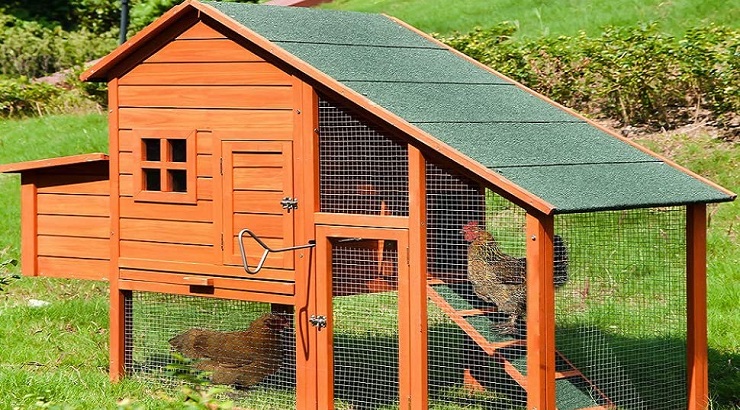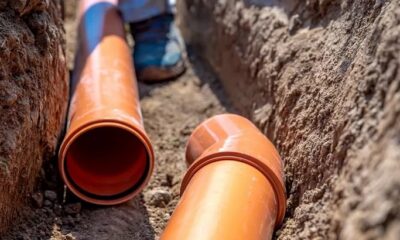Features
How to Build a Chicken House
Easy to follow guidelines for designing and building a chicken house.

Regardless of whether you plan to raise kienyeji (indigenous) chickens, broilers, or layers, building a secure and comfortable chicken house should be your utmost priority.
Start by sizing the house according to the scale of your poultry project. You will need two square feet of floor per chicken, and one nest box (one square foot) for every three hens.
This means you need around 235 square feet for 100 chickens.
As a rule, the width of the house should not exceed 9 metres when only natural ventilation is used to avoid suffocating the birds. The length can span as many metres as necessary depending on the number of chicken to be kept, and the space available.
On matters height, ensure that your structure is at least 2 metres tall to allow for easy access – without stooping. This height is also vital in ensuring better circulation of air.
For flooring, consider a concrete floor for easy cleaning. Alternatively, sand can be used, but ensure to place wire netting under and around the floor to deter predators.
Avoid wood due to difficulty in cleaning and disinfection.
Extend the roof beyond the wall to shield birds from direct sunlight and rain.
Here are simple guidelines to design and build a chicken house.
Poultry house design ideas
1. Consider size and location of the house
Size really matters when it comes to designing a chicken house. Ideally, there should be a minimum of two to three square feet per chicken inside the house and four to five square feet per bird in the open-air space.
It is also a good idea to build a chicken house under a large tree to provide shade during day time. If this is not available, be sure to shade the area with a shade cloth.
2. Create a rectangular frame
One of the best ideas when building a chicken house, is to start by erecting a rectangular frame and then adding other components such as walls, door and floor.
It is advisable to use naturally rot-resistant timber, e.g., redwood or cedar, instead of artificially treated wood that contains heavy metals that can harm your birds.
Step-by-step guide:
Step 1: Set four 4×4 upright posts in concrete in a rectangular shape depending on the size of the house that you want to set up. The length of the house should be twice the width.
The posts on the front side of the house should be 8 feet tall and the back ones 6 feet tall to allow the installation of a pitched roof over the walled part of the cage.
Step 2: Install a 4×4 post 2 feet from the right front corner of the structure. This pole should be 8 feet tall and is meant to support a gateway that will serve as a door to the run.
Step 3: Attach a 2×4 post in a horizontal position between the above-mentioned posts on the right front corner of the open-air space at a height of 6 feet.
Step 4: Create a gate frame for the entrance – a 2×6 foot rectangle – using 2×2 planks. Secure the gate frame to the right corner post with galvanized gate hinges.
RELATED: 11 Popular Types of Wood All DIYers Should Know
Step 5: Add parallel 4×4 posts about 30% of the distance from the left side of the rectangular frame. For instance, if the chicken house is 15 feet wide the posts should be placed about 5 feet on the left side corner posts.
These posts are meant to support the frame of the walled section of the coop and they should match the height of the other front and rear poles.
Step 6: Attach horizontal 2x4s to the tops of all the poles along the front and back sides of the rectangle. Add three more at an angle between the pairs of front and rear posts.
Step 7: Attach horizontal 2x4s to the four left-side posts, 24 inches above the ground, to support the walled portion’s floor.
Step 8: Install floorboards atop the 2×4 frame across the front two-thirds of the rectangle, securing them with galvanized nails or decking screws.
Step 9: Secure back a third of the floor with chicken wire. Birds perch above this part of the floor and the hardware cloth allows droppings to fall through for collection below.
Step 10: Dig a 12-inch trench all the way around the perimeter of the run and bury a ¼ inch hardware cloth to deter digging predators.
Fill the trenches with soil to hold the cloth in place.
Step 11: Secure the open-air run with chicken wire on all sides to deter predators.
3. Work on the interiors
Place a thick layer of straw over the ground of the run to absorb chicken droppings and moisture during the rains.
Dangle a waterer from one of the rafters using a bailing wire attached to a nail.
If the run is not under a tree, add a layer of shade cloth above the chicken wire ceiling. Erect a slightly sloping ramp at least 8 inches wide from the ground to the platform of house.
The enclosed area should have the following:
- Nest boxes – at least one 12-inch square box for every four birds.
- A roosting bar – made with 2A—2 wood along the back wall over the chicken wire floor.
- An incandescent bulb to extend the egg laying season.
Nest boxes can be wooden shelves or plywood dividers filled with straw and should be located along the front wall at least 24 inches above the floor.
A 2-inch piece of wood should be place across the front of the nest boxes to keep the straw from spilling out.
Chicken love to roost on the highest point and it is therefore advisable to place the roosting bars higher than the nest boxes.
If the reverse happens, the birds will use the nest boxes for roosting.
4. Work on the exteriors
This involves adding a roof and walls to enclose the nesting and roosting area. Tin is a popular material for the roof while wood siding is a great choice for the walls.
When constructing the walls, ensure easy access for egg collection and house cleaning.
It is also important to secure all the access point with raccoon-proof latches to stop thieves.
5. Work on ventilation
A chicken house should be well ventilated especially during summer.
While the door and the portion of the floor covered with wire mesh will let air in from below, it is important to create an opening for hot air to exit from the top of the house.
You can achieve this by either creating a gap between the roof overhangs and the upper wall sections or by installing vents close to the top of the walls.
Cover the spaces with chicken wire to keep off predators.












